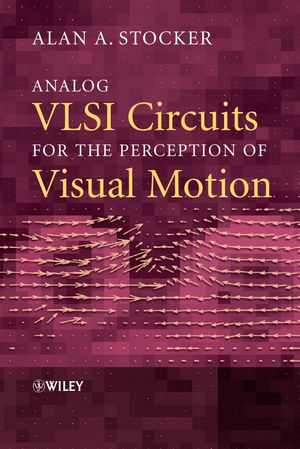Analog VLSI Circuits for the Perception of Visual MotionISBN: 978-0-470-85491-4
Hardcover
242 pages
May 2006
 |
||||||
Preface.
1 Introduction.
1.1 Artificial Autonomous Systems.
1.2 Neural Computation and Analog Integrated Circuits.
2 Visual Motion Perception.
2.1 Image Brightness.
2.2 Correspondence Problem.
2.3 Optical Flow.
2.4 Matching Models.
2.4.1 Explicit matching.
2.4.2 Implicit matching.
2.5 FlowModels.
2.5.1 Global motion.
2.5.2 Local motion.
2.5.3 Perceptual bias.
2.6 Outline for a Visual Motion Perception System.
2.7 Review of aVLSI Implementations.
3 Optimization Networks.
3.1 AssociativeMemory and Optimization.
3.2 Constraint Satisfaction Problems.
3.3 Winner-takes-all Networks.
3.3.1 Network architecture.
3.3.2 Global convergence and gain.
3.4 Resistive Network.
4 Visual Motion Perception Networks.
4.1 Model for Optical Flow Estimation.
4.1.1 Well-posed optimization problem.
4.1.2 Mechanical equivalent.
4.1.3 Smoothness and sparse data.
4.1.4 Probabilistic formulation.
4.2 Network Architecture.
4.2.1 Non-stationary optimization.
4.2.2 Network conductances.
4.3 Simulation Results for Natural Image Sequences.
4.4 Passive Non-linear Network Conductances.
4.5 Extended Recurrent Network Architectures.
4.5.1 Motion segmentation.
4.5.2 Attention and motion selection.
4.6 Remarks.
5 Analog VLSI Implementation.
5.1 Implementation Substrate.
5.2 Phototransduction.
5.2.1 Logarithmic adaptive photoreceptor.
5.2.2 Robust brightness constancy constraint.
5.3 Extraction of the Spatio-temporal Brightness Gradients.
5.3.1 Temporal derivative circuits.
5.3.2 Spatial sampling.
5.4 Single Optical Flow Unit.
5.4.1 Wide-linear-range multiplier.
5.4.2 Effective bias conductance.
5.4.3 Implementation of the smoothness constraint.
5.5 Layout.
6 Smooth Optical Flow Chip.
6.1 Response Characteristics.
6.1.1 Speed tuning.
6.1.2 Contrast dependence.
6.1.3 Spatial frequency tuning.
6.1.4 Orientation tuning.
6.2 Intersection-of-constraints Solution.
6.3 Flow Field Estimation.
6.4 DeviceMismatch.
6.4.1 Gradient offsets.
6.4.2 Variations across the array.
6.5 Processing Speed.
6.6 Applications.
6.6.1 Sensor modules for robotic applications.
6.6.2 Human–machine interface.
7 Extended Network Implementations.
7.1 Motion Segmentation Chip.
7.1.1 Schematics of the motion segmentation pixel.
7.1.2 Experiments and results.
7.2 Motion Selection Chip.
7.2.1 Pixel schematics.
7.2.2 Non-linear diffusion length.
7.2.3 Experiments and results.
8 Comparison to Human Motion Vision.
8.1 Human vs. Chip Perception.
8.1.1 Contrast-dependent speed perception.
8.1.2 Bias on perceived direction of motion.
8.1.3 Perceptual dynamics.
8.2 Computational Architecture.
8.3 Remarks.
Appendix.
A Variational Calculus.
B Simulation Methods.
C Transistors and Basic Circuits.
D Process Parameters and Chips Specifications.
References.
Index.



